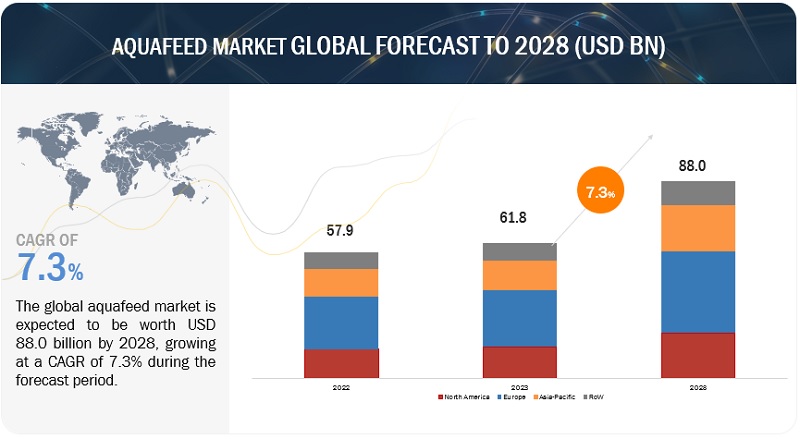
According to a research report, “Aquafeed Market by Species (Fish, Crustaceans, and Mollusks), Ingredient (Soybean, Corn, Fishmeal, Fish Oil, and Additives), Lifecycle (Starter Feed, Grower Feed, Finisher Feed, and Brooder Feed), Form, Additive, and Region – Global Forecast to 2028″ published by MarketsandMarkets, the aquafeed market is projected to reach USD 88.0 billion by 2028 from USD 61.8 billion by 2023, at a CAGR of 7.3% during the forecast period in terms of value. The global demand for aquafeed products is increasing due to several factors. Firstly, there is a growing population that requires a sustainable and efficient source of protein, and aquaculture provides a solution. Secondly, the decline of wild fish stocks has led to an increased reliance on farmed fish. Lastly, advancements in aquafeed technology have improved the nutritional value and efficiency of feeds, supporting the growth and health of aquaculture species.
Download PDF Brochure: https://www.marketsandmarkets.com/pdfdownloadNew.asp?id=1151
The soybean segment of the ingredients segment accounted for the largest share of the aquafeed market in 2023 in terms of value.
Soybeans are a rich source of high-quality protein, essential amino acids, and energy, making it a suitable replacement for fishmeal, which is limited and expensive. Moreover, soybeans are readily available and widely cultivated, ensuring a stable supply. Additionally, it is a sustainable alternative to marine-based ingredients, reducing pressure on wild fish stocks. Soybean’s versatility allows for the formulation of nutritionally balanced and cost-effective aquafeed, contributing to its increasing importance in the aquaculture industry.
The dry segment within the form segment is projected to grow at the highest share of the aquafeed market from 2023 to 2028.
The demand for dry-form aquafeed products is rising because, when compared to other types of feed, such as wet or frozen feeds, dry-form feeds have a longer shelf life and are simpler to handle and store. They are now more practical for distributors and farmers in aquaculture. Moreover, dry-form feeds don’t require specialized equipment or temperature control to be carried over large distances. This makes it possible to ship aquafeed products to faraway places. Additionally, specific nutritional content of dry form feeds can be created, enabling precise and controlled feeding procedures in aquaculture operations.
The fish segment of the species segment is estimated to grow at the highest rate in the aquafeed market.
Fish is the cheapest and easiest-digestible animal protein. However, due to excessive exploitation of resources and pollution, the availability of fish in natural waters has declined considerably. This has resulted in the adoption of various methods to increase production. Fish farming and aquaculture in controlled conditions or in artificial settings have become easier ways to increase fish production and its availability for consumption.
The grower segment of the lifecycle segment is estimated to grow at the highest rate in the aquafeed market.
Essentially, as aquaculture production rises and more fish and prawns enter the grow-out stage, there is an increased demand for grower feeds. The demand for specialized feeds that meet the dietary needs of aquatic species increases as aquaculture farms expand their operations. Furthermore, grower feeds are designed to support quick growth, greater disease resistance, and higher feed conversion ratios, all of which are crucial for increasing yields and profitability. To address the unique requirements of the aquaculture business at this level of production, the grower segment is expanding.
The amino acids segment of the additives segment is estimated to grow at the highest rate in the aquafeed market.
Amino acids, which are the fundamental building blocks of amino acids, are vital for the growth, development, and general health of aquatic animals. There is a rising understanding of the need to provide balanced and ideal nutrition to farmed fish and prawns as the aquaculture industry expands and intensifies. Lysine, methionine, and threonine are important building blocks in the formulation of feeds that satisfy the distinct dietary needs of numerous aquatic species at various stages of growth. These amino acids serve as building blocks for protein synthesis, promoting immune system health and reproductive efficiency.
Request Sample Pages: https://www.marketsandmarkets.com/requestsampleNew.asp?id=1151
In 2028, the Asia Pacific region accounted for the largest growing market, in terms of value, of the global aquafeed market.
Aquaculture thrives in the Asia Pacific region because of its large coasts, abundance of water resources, and a temperate environment. These elements encourage the development and expansion of aquaculture farms, which increases the demand for aquafeed products. The nutritional quality and efficacy of feeds have been improved by advances in aquafeed technology and research, which have increased the growth rates, illness resistance, and overall productivity of aquatic animals raised for food. The demand for aquafeed products is being further fueled by regional aquafeed manufacturers’ increased focus on creating customized feed formulations that address the unique nutritional needs of diverse aquaculture species.
The key players in this market include ADM (US), Cargill, Inc. (US), Ridley Corporation Limited (Australia), Nutreco (Netherlands), Alltech (US), Purina Animal Nutrition (US), Adisseo (Belgium), Aller Aqua A/S (Denmark), Biomin (Austria), Biomar (Denmark), Norel Animal Nutrition (Spain), Avanti Feeds Limited (India), De Heus Animal Nutrition B.V. (Netherlands), Novus International (US), and Biostadt India Limited (India).


































